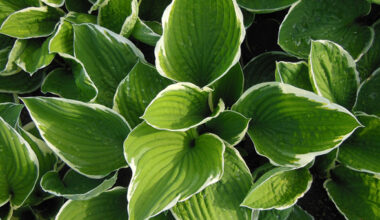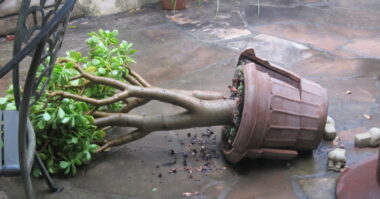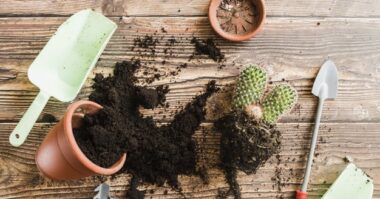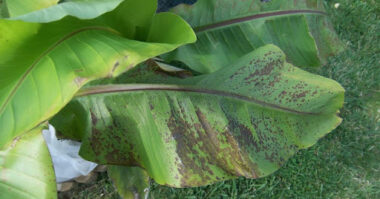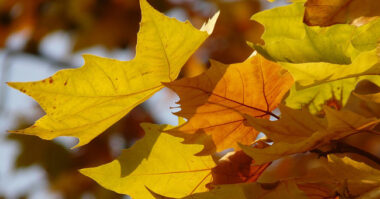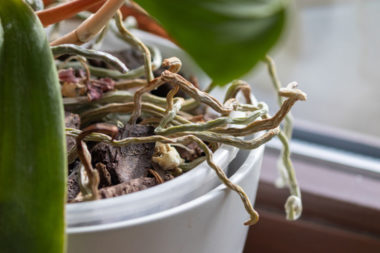Generally, bonsai do not die of old age, so there is a good chance that one of the following 5 reasons is the cause of your bonsai’s death:
- You forgot to water it
- You have watered it too much (excessively)
- Put a bonsai outside indoors
- Lack of lighting
- Lack of patience
Contents
5 reasons why your bonsai is dying
-
You forgot to water it
Bonsai are planted in small pots, so they do not have a lot of reserves of nutrients and water at their disposal. If you do not water your Bonsai before the soil dries completely, the roots will dry out and die. In a few days you will see the leaves wither and fall off.
If the roots have not completely dried out, you can save the tree by watering it properly in the future.
So, how often should I water? This really depends on your tree and the soil in which it is planted. I can’t give a rule; you have to check the moisture content of the soil, and don’t water until it starts to dry out a bit. Most cheap Bonsai are planted in soil that looks like clay (only in this way can they be imported from China in large containers).
This soil does not absorb water quickly, so when you water your tree too quickly, and therefore insufficiently, there is a good chance that the water will end up under the pot, rather than in the soil. Make sure that the water penetrates properly: water your tree, then wait a few minutes before watering it again, to make sure that all the soil is moistened. When your tree has recovered well, repot it in a suitable soil mixture.
-
You watered it too much
I explained above the importance of land: some land retains water very well, and in this case, over-watering can be a big problem. If your tree is planted in soil that retains water well and is constantly very wet, the roots will begin to rot and the tree will die. While a lack of watering can kill it in a few days, over-watering will kill it in a few weeks.
-
Putting a bonsai outside indoors
Juniper is one of the most common Bonsai trees for beginners, but it is an outdoor tree. When placed indoors, its needles turn yellow and it dies little by little. Now that you have identified the species of your tree, you know where to place it.
In general, place an indoor bonsai near a south-facing window, and an outdoor bonsai in a well-lit area protected from strong winds.
-
Lack of lighting
Most, if not all, indoor bonsai trees are tropical and subtropical. Because of this, they need a lot of light, and the majority of homes are simply not bright enough for them. It is imperative to place your tree near a south-facing window, there is no other solution.
-
Lack of patience
Some beginners try to reshape their tree very frequently; you don’t need to be an expert to realize that it doesn’t work. Major changes, such as repotting or radical pruning, should only be done once a year, at the right season. In the meantime, take care of your tree and prune it to maintain its shape, but don’t try to make major changes more than once a year.
Attack of your bonsai
Even if it is rarer, a mite or spider mite attack can be the cause of a leaf problem on your bonsai. You can identify these parasites if you see spiders (often red) or webs on your bonsai. To get rid of them, nothing is better than a good shower. To do so, shower your bonsai thoroughly for a few seconds.
If the problem persists, it will be necessary to eliminate these parasites with the help of an adapted product that you can find at the bonsai professionals or in a specialized garden center. Before applying a treatment, read the instructions for use carefully and do not hesitate to ask a professional for quick advice.

Symptoms:
- Leaves that are eaten or devoured.
- Leaves with orange spots.
- Leaves with white areas or spots.
- Presence of black shells on the branches.
- Insects present on the branches or in the pot.
Explanation of symptoms
The bonsai loses its leaves in autumn
It’s autumn and your bonsai is losing its leaves? The leaves are yellow and falling? It’s normal!
This is part of the life cycle on so-called deciduous trees. We can find this phenomenon on maple, beech, Chinese elm… The days are shorter and the luminosity is less, the bonsai gets rid of its leaves. Your tree is not dead! If you water it properly and it is placed in a luminous place adapted to its species, it should bud again in spring.
Yellow or black leaves
Yellowing leaves indicate a problem with watering, location or light. This symptom is often followed by leaf drop.
If your bonsai has leaves that turn black or have black spots, this is a sign of over-watering or over-humidity. In general, rotting of the young buds is also usually noticed.
Watering is a delicate thing and should only be done when the substrate has dried well. Spread the watering out and check the light exposure of the bonsai.
Leaves with orange spots
Leaves with orange spots appear on rust affected subjects. It is a disease that often affects fruit bonsai trees. To prevent leaf loss, cut off the affected leaves.
The ends of the leaves are dried out
Scorched, dry, curled, twisted, tense or damaged leaf tips can be seen on Japanese maples (Acer Palmatum) from spring to autumn.
This is often due to excessive exposure to wind or sun, or to dry air (insufficient humidity).
For more information on watering, location, exposure, see our maple bonsai guide.
Twisted or deformed sheets
Twisted and deformed leaves are often coupled with the formation of black spots on the top or edge of the foliage. This symptom is characteristic of over-watering.
How to save your bonsai
The only thing to do from now on is to take good care of your tree. Never forget to water it and place it in the right place. Hopefully it will recover!

How to take care of your bonsai
Bonsai does not like excess water.
Excess water can cause the roots to rot. Bonsai recovers more easily from a lack of water than from excess water. Therefore, avoid water saucers and drain off any excess water above the substrate after watering to prevent root asphyxiation.
Light and temperature for bonsai cultivation
Outdoor bonsai trees have the same light requirements as trees living in their natural environment. Beware of the sun in the summer, which can burn the leaves of some species. If necessary, place a shade cloth or place the pots in light shade.
Indoor bonsai trees are placed near the window. A lack of light will cause the tree to “stretch” towards a light source and the opposite is desired.
The repotting of bonsai
Little by little, the roots will take up more and more space in the pot and will find it increasingly difficult to feed themselves. It is necessary to repot the bonsai. The repotting is done in spring, at the beginning of vegetation:
- Every 3 to 5 years for conifers ;
- Every 2/3 years for deciduous trees;
- Every 1 or 2 years for fruit trees;
- Every 2 years for indoor bonsai trees.
However, the older the subject is, the less it needs to be repotted.
Summary
Most of the time, a bonsai does not die from aging, so it is likely that the problem comes from a lack of maintenance, we give you 5 tracks (and 5 solutions) to understand your bonsai and save it if possible! Most of the time, the problem is either related to watering or exposure !

